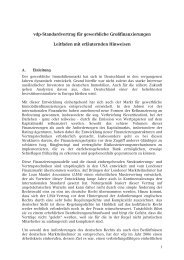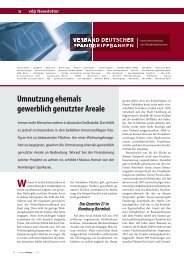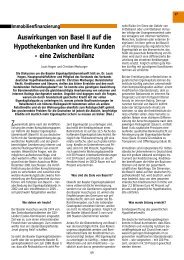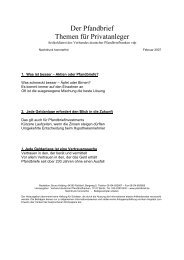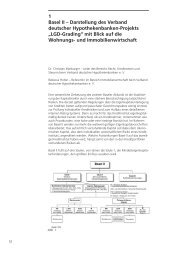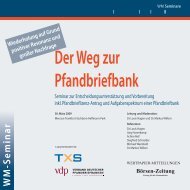The Pfandbrief 2011 | 2012
The Pfandbrief 2011 | 2012
The Pfandbrief 2011 | 2012
Create successful ePaper yourself
Turn your PDF publications into a flip-book with our unique Google optimized e-Paper software.
<strong>The</strong> question of the ETF’s replication form reveals both advantages and disadvantages in<br />
the respective structural form. Whereas “full replication” involves an actual investment in all<br />
index components in the respective weightings, “swap-based replication” has to do with a<br />
total-return swap on the basis of the underlying index. Full replication has the advantage of<br />
being clearly structured and independent of any quality fluctuations of the counterparty to the<br />
total-return swap. However, the disadvantage is that, particular with relatively non-liquid index<br />
assets, the net asset value can deviate more significantly from the rate on the exchange. On<br />
the other hand, the total volume of a swap-based replicated ETF is more easily scalable, since<br />
there is no need to move any certificates but rather only adjust the swap’s nominal value.<br />
Summary<br />
Due to their myriad intricacies, indices in the fixed-income market generally and the coveredbond<br />
market specifically play a subordinate role in comparison to equities markets. To begin<br />
with, index affiliation is nearly always based on a defined size and a certain ratings classification<br />
and generally remains in place over the entire period of maturity. This applies in particular<br />
to covered-bond markets, which show relatively low volatility with respect to ratings. New<br />
listings and exclusions, which often occur in equities markets, are rare. While a covered-bond<br />
index status may be of importance for all investor groups from an informational standpoint,<br />
these indices are directly relevant for select investor groups in connection with performance<br />
measurement – including, in particular, asset managers and central banks, as well as specific<br />
investor groups that do not need to take into account an externally mandated disbursement<br />
profile. Since investment strategies in covered bonds are linked to the macro-allocation,<br />
“off-the-rack” global indices are only second-best when compared to individually calculated<br />
indices, which in turn can be comprised of sub-indices of global index families. <strong>The</strong> direct<br />
application of indices in connection with ETFs continues to lead a shadow existence. Although<br />
the range of options is extremely flexible and cost-efficient, particularly when it comes to coresatellite<br />
strategies, they come with significant restrictions with respect to tradable sizes and<br />
the fact that only long-only strategies can be pursued.<br />
55




